This is our fourth part of a series of posts on (a few selected) hidden realities : many-worlds interpretation of quantum mechanics, multiverse linked to the space-time geometries and dynamics, higher dimensional multiverse, holographic multiverse and simulated multiverse.
For the previous posts, please see:
- On hidden realities (part 1) – Many-worlds interpretation of quantum mechanics
- On hidden realities (part 2) – Space-time geometries and dynamics
- On hidden realities (part 3) – Higher dimensional universes
Now it is time to speak a bit about the holographic principle.

Holograms
Holograms are recordings on 2-D photographic plates of light scattered from 3-D objects.
The hologram in itself is not an image. It is usually unintelligible when viewed under diffuse ambient light. It is an encoding of the light field as an interference pattern :
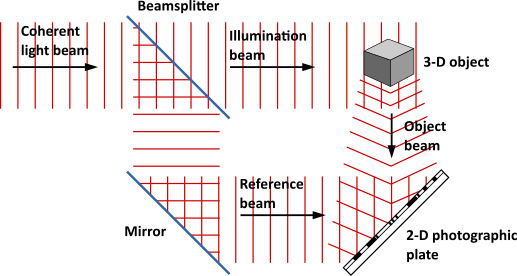
When suitably lit, the interference pattern diffracts the light into a reproduction of the original light field and the objects that were in it appear exhibiting parallax and perspective that change realistically with any change in the relative position of the observer.
Although holograms often pop up in film sagas such as “Star Wars” or “Iron Man”, it has not quite caught up this movie magic when they pop up in real life:

Buf even if holograms are not as sexy as they appear on these movies, keep the idea in mind: hologram are the encoding of 3D information on a 2D surface.
Plato’s allegory of the cave
About 2450 years ago, Plato wrote a series of 35 Dialogues and 13 letters in which the great Greek philospher summarized many of his thoughts (and his teachers’, Socrates).
Perhaps one of the most famous of these Dialogues is the “Allegory of the Cave“, part of Plato’s “Republic“, that we all learned at school.
In this allegory, people are chained in a cave so that they can only see from the world the shadows which are cast on the walls of the cave by a fire.
To these people, the shadows represent the totality of their existence – it is impossible for them to imagine a reality which consists of anything other than the fuzzy information cast on a wall.
However, some prisoners may escape from the cave – they then go out into the light of the sun and behold reality.
But when they try to go back into the cave and tell the other captives the truth, they are mocked as madmen … This story was meant to symbolize mankind’s struggle to reach enlightenment and understanding through reasoning and open-mindedness. We are all initially prisoners and the tangible world is our cave. But, escaping from the cave, people can acquire knowledge and ascend into the light of reality.
This allegory can alos be taken from another perspective: could reality be represented completely as “shadows” on the walls ?
The holographic principle
In 1993 Gerard ‘t Hooft put forward a bold proposal which is reminiscent of Plato’s “Allegory of the Cave“. It was later given a string-theory interpretation by Leonard Susskind (combining his own new ideas with Gerard ‘t Hooft’s and Charles Thorn‘s).
The hologram principle is a proposed property of quantum gravity. It’s first assertion is that the description of a volume of space can be thought of as encoded on a boundary to the region (preferably a light-like boundary like a gravitational horizon): all of the information contained in some region of space can be represented as a “hologram”. Much like “real-life” hologram encode 3D information on a 2D plate. Only, here, the hologram “lives” on the boundary of that region of space.
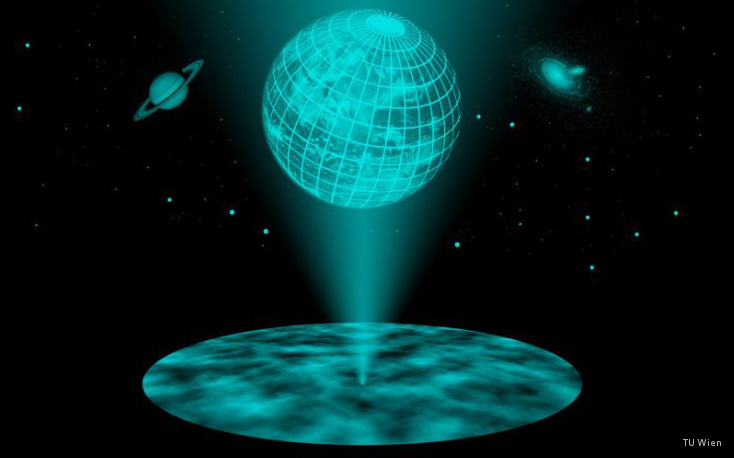
It’s second assertion is that the boundary of the region of space in question should contain at most one degree of freedom per Planck area. A Planck area is the area enclosed by a little square which has side length equal to the Planck length, usually denoted as .
The holographic principle was inspired by black hole thermodynamics, which conjectures that the maximal entropy in any 3D region scales with the radius squared – and not cubed as might be expected. Indeed, Jacob Bekenstein‘s formula for black hole entropy is , where
is the surface of the black hole’s event horizon.
Theoretical physicists have then suggested that entropy or information on matter/energy inside the black hole is encoded on the 2D surface of the event horizon, similar to holography.
As we will see later on, the holographic principle can also be applied to tackle the information paradox we introduced previously.
Dualities and M-Theory
Unifications have been more than useful for our understanding of natural laws. As we have seen earlier, the electric and magnetic interactions turned out to be two different aspects of the same electromagnetic interaction. The electromagnetic interaction has later been unified with the weak nuclear interaction. Yet, nobody has succeeded in unifying all presently known interactions, the electromagnetic with the strong and weak nuclear ones, plus gravity.
String theory was first conceived as a theory of the strong nuclear interaction, and I had the chance to be taught advanced quantum field theory by Xavier Artru, one of its early proponents.
It soon became apparent that quantum chromodynamics (QCD), the theory of quarks and gluons, did a better job. But, string theory gained second wind after physicists discovered it may serve to explain all the known interactions including gravity.
In time, it turned out to be difficult to get the Standard Model of particle physics back from string theory and … string theory turned into many string theories. The quest for unification has slowly been replaced with a quest for dualities that demonstrate that all the different types of string theories were actually different aspects of the same theory. A duality is a relation that identifies two theories. In a “normal” unification, two theories are somehow merged to a larger theory that contains the former two. If you relate two theories by a duality, you show that the theories are the same: they just appear different, depending on how you look at them.
And indeed, this last decades, theorists have found dualities between theories in a different number of space-time dimensions. M-Theory is one of these theories.
M-theory tries to unifiy all consistent versions of superstring theory. The existence of such a theory was first conjectured by Edward Witten. Prior to Witten, string theorists had identified five versions of superstring theory (Type I theory, II A & B theories, SO(32) and E8xE8 heterotic theories). It was shown that these theories were related through mathematical transformations called S-duality and T-duality :
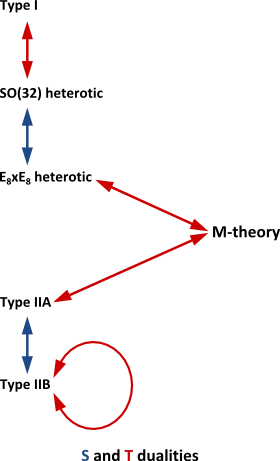
The adS-CFT correspondence is a another form of duality. It relates two distinct physical theories. On one side of this duality is the physics of gravity in a space-time we’ve encountered before on our journey in hidden realities: the anti-de Sitter space (adS).
Five-dimensional anti-de Sitter space has a boundary which is four-dimensional, and in a certain limit looks like flat space-time with one time and three space directions.
The adS-CFT correspondence states that the physics of gravity in five-dimensional anti-de Sitter space, is equivalent to a N=4 supersymmetric Yang-Mills theory defined on the boundary of adS. This Yang-Mills theory is thus a “hologram” of the physics which is happening in five dimensions. And good old Yang-Mills theories are at the heart of the Standard Model of particle physics. Which is what theorists were looking for.
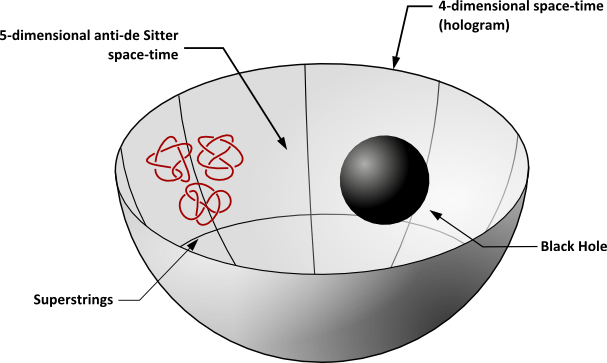
In M-theory we are the shadows on the wall. The “room” is some larger, five-dimensional space-time and our four-dimensional world is just the boundary of this larger space. The bulk is often the name given to this hypothetical higher-dimensional space within which the eleven dimensions of our universe exists. This duality is said to be “holographic” because it tells us that everything allowed to happen in the bulk is encoded on the boundary of that space.
Now, keep in mind that oue universe has a positive cosmological constant whereas the Anti-de Sitter solution describes a universe with a negative (attractive) cosmological constant.
Furthermore, the Yang-Mills theory related to adS is supersymmetrical. And as far as we know, there is no sign of supersymmetric particles, and the last results from LHC have put new constraints on their existence (at least in the scope of the Minimal Supersymmetric Standard Model).
Ironically, string theory has found its way back into the game of strong interactions. Light front holographic QCD is an approximate version of the theory of quantum chromodynamics which results from mapping the gauge theory of QCD to a higher-dimensional anti-de Sitter space inspired by the AdS/CFT correspondence. This procedure makes it possible to find analytic solutions in situations where strong coupling occurs.
Are we living in flatland ?
We have seen even if the AdS-CFT correspondence is an important area of theoretical physics, it does not seem to have much to do with our own universe. From what we know, we do not live in such an anti-de Sitter space. These spaces have quite peculiar properties: they are negatively curved, any object thrown away on a straight line will eventually return. Our universe, in contrast, is quite flat, and on astronomic distances, it has positive curvature …
But many researchers are presently working on expanding this duality to include spaces with a positive cosmological constant or none. New calculations have actually shown that a two-dimensional universe projecting a holographic appearance of three dimensions could also take place if space-time were flat. For three years, Daniel Grumiller and his team at TU Wien and around the world have been working on that matter. An article has been published in Physical Review Letters, confirming the validity of the correspondence principle in a flat universe.
Beyond these theoretical considerations, there’s the entirely different matter of pulling back the illusion and experimentally observing the holographic nature of reality. As it happens, physicists at the Department of Energy’s Fermilab are now trying to do just that.
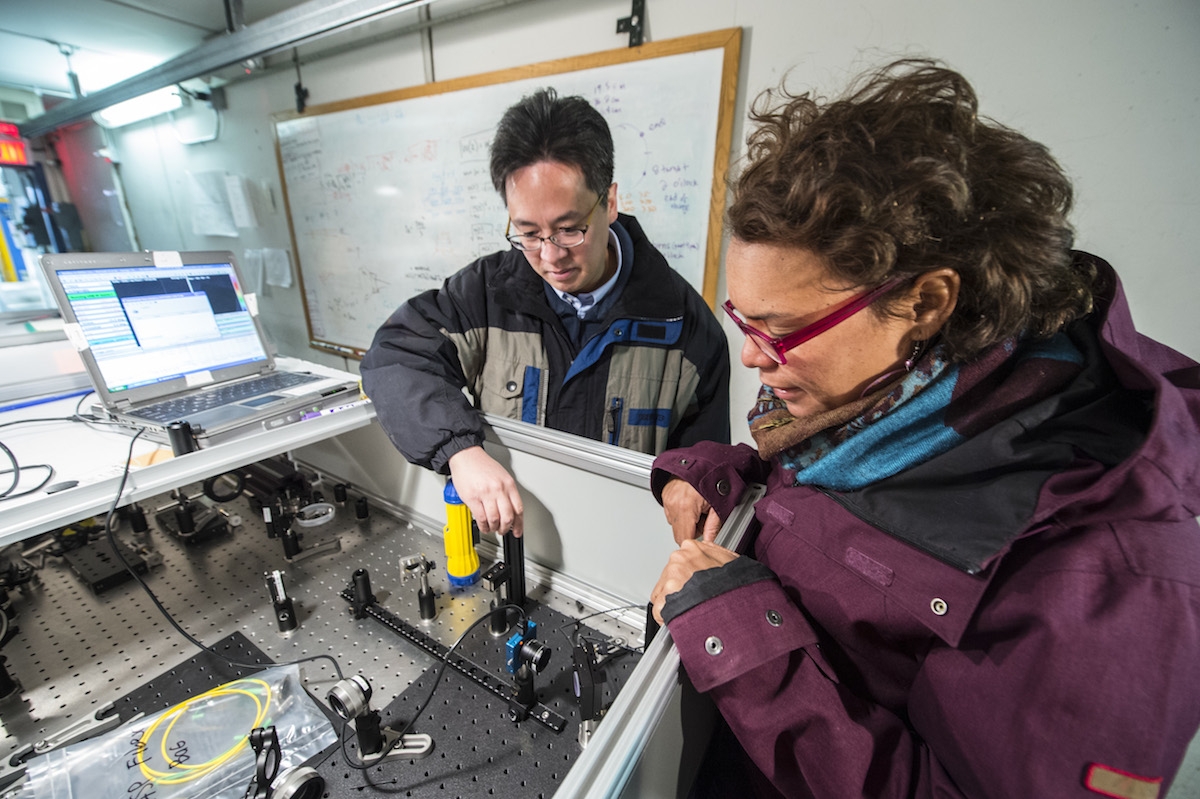
Fermilab’s holometer is intended to be the world’s most sensitive laser interferometer. It’s aim is to surpass the sensitivity of the other interferometers like LIGO, and (among other things) to detect holographic fluctuations in space-time.
This holometer should be capable of detecting fluctuations in the light of a single attometer, meeting or exceeding the sensitivity required to detect the smallest units in the universe .
Planck areas can seen a pixel-like bits of information. To quote particle Astrophysics Craig Hogan ”To our macroscopic eyes, everything around us appears three-dimensional. But just as moving your face toward the TV screen will cause pixels to come into focus, if we stare deeply enough into matter on a subatomic level, the bitmap of our holographic universe might reveal itself“.
So, if this depiction of space as pixel-like bits of information is correct, then, like any computer, there is an inherent limit to the universe’s data storage and processing capacity.
If we are indeed living in a hologram, “the basic effect is that reality has a limited amount of information, like a Netflix movie when Comcast is not giving you enough bandwidth. So things are a little blurry and jittery. Nothing ever just stands still, but is always moving a tiny bit.”
Since 2014, Fermilab holometer started collecting this “holographic noise”. Although some physicists are skeptical that the apparatus will successfully detect the holographic fluctuations, if the experiment is successful, it would be the first proof that space-time, the fabric of the universe, is quantized.
In a paper about the project titled Now Broadcasting in Planck Definition, Craig Hogan ends with the statement “We don’t know what we will find” …
Hawking’s new proposition on the information paradox
We introduced the black hole information paradox in a previous post. As far as we know (no-hair theorem), from outside a black hole, there are only a 3 properties that we can discern at all:
- its mass,
- its electric charge,
- its angular momentum
And … that’s it, whatever information “falls in” !
On the other hand, black holes are not totally black. Vacuum fluctuation in the vicinity of a black hole event horizon is at the origin of Hawking radiation:
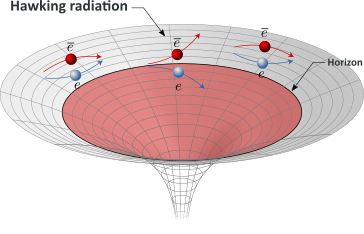
Eventually, a black hole evaporates through this loooooooonnnnnnnng (of the order of the age of the universe) process. And here lies the black hole information paradox:
- All information “gathered” by the black hole would disappear
- From what we observed of Mother Nature, she never loses information
The Thorne–Hawking–Preskill bet was a public bet on the outcome of the black hole information paradox, made in 1997 by physics theorists Kip Thorne and Stephen Hawking on the one side, and John Preskill on the other.
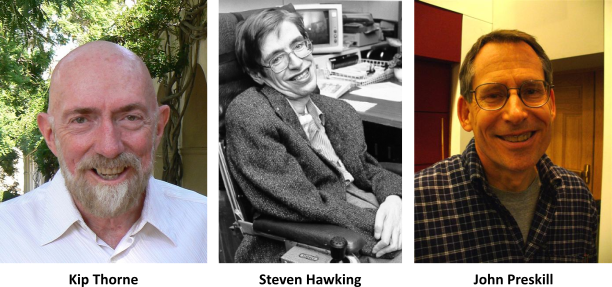
Thorne and Hawking argued that since general relativity made it impossible for black holes to radiate, and lose information, the mass-energy and information carried by Hawking radiation must be “new”, and must not originate from inside the black hole event horizon. Preskill argued that since quantum mechanics suggests that the information emitted by a black hole relates to information that fell in at an earlier time, the view of black holes given by general relativity must be modified in some way.
In 2004, Hawking announced that he was conceding the bet, and that he now believed that black hole horizons should fluctuate and leak information
In between, Gerard ‘t Hooft and Leonard Susskind came up with the holographic principle.
The natural assumption is that somehow, information must be preserved. Up until now, nobody knew how, although there were some ideas. The general assumption was that information from the surface of the black hole must somehow get encoded into the outgoing Hawking radiation.
This week, Stephen Hawking - along with his collaborators Malcolm Perry and Andrew Strominger - proposed that is that there’s something arising from string theory known as “supertranslations”.
A supertranslation, in the simplest terms possible, takes a well-known fact about the classical vacuum in general relativity: it’s highly degenerate. You have different vacuum states which are indistinguishable from one another. Different vacua which correspond to different states can be related to one another by a broken symmetry. These broken symmetries are the “supertranslations” that Strominger works on, and they can describe how changes in a gravitational field propagate. [Extract from “Ask Ethan” blog]
Hawking said that after attending to a talk by Strominger, he came up with the idea that black hole horizons also have supertranslations, caused by the in-going particles. He claims that supertranslations are a hologram of the in-going particles. Information is stored on the horizon in form of supertranslations, which can make a tiny delay for the emission of Hawking particles. Which presumably can encode information in the radiation.
Essentially Hawking changed his mind and claims that our universe has holographic properties even though it has a positive cosmological constant, and that the horizon of a black hole also serves as a surface that contains all the information of what happens in the full space-time.
By itself, this is not a new idea at all. What is new in his work with Malcom Perry and Andrew Strominger is the claim to have a way to store and release the information through supertranslations.
Details of how this is supposed to work however are so far not clear… After Malcom Perry’s talk, some more details have nevertheless emerged. Their proposition is a purely classical picture, at least for now. One would expect a quantized version. But there isn’t one so far. Neither is there, at this point, a clear picture on how information gets into the outgoing radiation. My gut feeling it that quantum effects would mangle back information. And it would drive us right back to the information paradox.
Actually, the scientific community reacted with much skepticism to Hawking’s recent communication. Some physicists who attended the communication – among which some of the theoreticians I revere the most, like Gerard ‘t Hooft or Carlo Rovelli – felt somewhat unsatisfied by Hawking’s answers to their questions.
To be frank, is feels half-baked. All this fuzz feels like the usual bad hype surrounding Hawking communications in media. Let’s wait for the publication, which hopefully will be published soon, and let’s see if it turns out to be something special or if the information paradox is still there for some times.
Poetic (?) ending
The Phantom Zone is a prison featured in the Superman comic books and related media published by DC Comics. It is an “interdimensional” realm outside the normal space/time continuum, discovered by Jor-El and used on the planet Krypton as a method of imprisoning criminals.
In Richard Donner‘s 1978 Superman film, the Phantom Zone is presented as a large, flat rhombus-shaped spinning mirror. Jor-El (played by Marlon Brando) imprisoned General Zod and his co-conspirators, who appear to be transferred from a 3D universe and trapped into a 2-D space on the mirror’s surface.
I guess even if Marlon Brando wore what is probably one of the most terrible wig in the history of film making (only bested so far by Nicolas Cage), it seems that Kryptonians new a bit about the holographic principle.
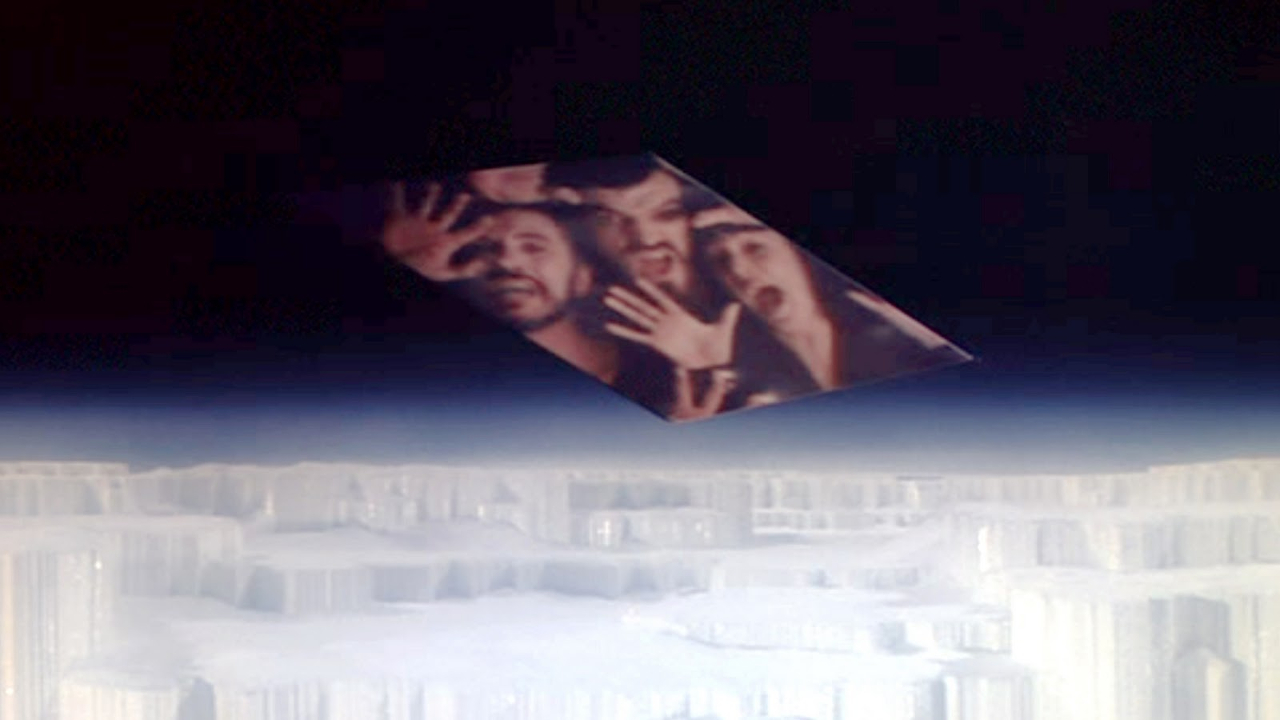
Pingback: Darth Vader Pays Tribute to Stephen Hawking, Discusses Black Holes – मंथन